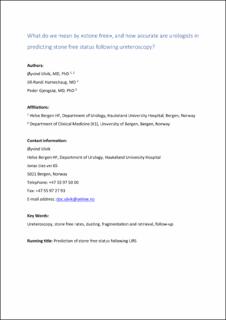| dc.contributor.author | Ulvik, Øyvind | |
| dc.contributor.author | Harneshaug, Jill-Randi | |
| dc.contributor.author | Gjengstø, Peder | |
| dc.date.accessioned | 2021-06-02T08:14:41Z | |
| dc.date.available | 2021-06-02T08:14:41Z | |
| dc.date.created | 2021-01-21T11:39:19Z | |
| dc.date.issued | 2021 | |
| dc.identifier.issn | 0892-7790 | |
| dc.identifier.uri | https://hdl.handle.net/11250/2757310 | |
| dc.description.abstract | Background and Purpose: No consensus exists on how stone-free rates (SFRs) should be reported after stone treatment. The aim of this study was to assess how accurate urologists predict their patients being stone free after completing ureteroscopy (URS) and to see how various treatment strategies influenced the precision of these predictions. We also wanted to study how different definitions of stone-free status (SFS) affected the results and propose a standard definition of “stone free” to be used in future studies.
Materials and Methods: A retrospective evaluation of 1019 URS done for stone treatment at Haukeland University Hospital between 2013 and 2018 was performed. Data on pretreatment status, the surgical procedure, and follow-up were recorded. SFS was defined as either no fragments detected on computed tomography (CT) after 3 months or as practical stone-free status, which also included those with small residual fragments not needing further treatment. Exact chi-squared and independent-samples t-tests were used comparing data between different treatment modalities.
Results: The overall SFR, irrespective of treatment strategy and location of stone, using the no residual fragments and practical stone-free definitions were 54.2% and 74.7%, respectively. Urologists predicted intraoperatively that 91.0% of their patients treated with fragmentation and extraction would be stone free compared to 76.8% of patients treated with dusting, p < 0.0001. At follow-up, the actual SFRs with no residual fragments for the two treatment strategies were 68.0% and 35.5%, respectively, p < 0.0001. The practical SFRs for fragmentation and retrieval were 83.1% and 64.8% for dusting, p < 0.0001.
Conclusion: The different definitions of SFS have great impact on SFRs. Urologists are far too optimistic predicting their patient being stone free after URS. SFS should be defined as no fragments detected on CT 3 months after the URS procedure when presented in studies. | en_US |
| dc.language.iso | eng | en_US |
| dc.publisher | Mary Ann Liebert | en_US |
| dc.title | What Do We Mean by "Stone Free," and How Accurate Are Urologists in Predicting Stone-Free Status Following Ureteroscopy? | en_US |
| dc.type | Journal article | en_US |
| dc.type | Peer reviewed | en_US |
| dc.description.version | acceptedVersion | en_US |
| dc.rights.holder | Copyright 2021, Mary Ann Liebert, Inc., publishers | en_US |
| cristin.ispublished | true | |
| cristin.fulltext | postprint | |
| cristin.qualitycode | 1 | |
| dc.identifier.doi | 10.1089/end.2020.0933 | |
| dc.identifier.cristin | 1876420 | |
| dc.source.journal | Journal of endourology | en_US |
| dc.source.pagenumber | 961-966 | |
| dc.identifier.citation | Journal of endourology. 2021, 35 (7), 961-966. | en_US |
| dc.source.volume | 35 | |
| dc.source.issue | 7 | |
